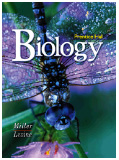BIOLOGY
by Miller & Levine
[complete Table of Contents]

|
Use the pull-down menu to jump to any of the Book's 40 Chapters: |
Additional Resources:
Why
Study Photosynthesis?
Because it's the most important biological
process on earth, as this site explains.
An
Introduction to Photosynthesis
A description of the process, from Arizona State University.
Using
Photosynthesis in the Classroom
A useful guide for teachers from the Science Ed Standards.
Separating
Photosynthetic Pigments
A lab exercise that enables your students to separate and study photosynthetic
pigments.
In this chapter, students will read about the process of photosynthesis, which captures the energy of sunlight to provide nearly all of the energy for life on Earth. They will read about the major steps in this process, and how it uses the energy of sunlight to convert water and carbon dioxide gas into sugars that provide energy and structural material for the growth and development of living things.The links below lead to additional resources to help you with this chapter. These include Hot Links to Web sites related to the topics in this chapter, the Take It to the Net activities referred to in your textbook, a Self-Test you can use to test your knowledge of this chapter, and Teaching Links that instructors may find useful for their students.
| Hot Links | Take it to the Net |
| Chapter Self-Test | Teaching Links |
What are Web Codes? |
Web
Codes for Chapter 8: Active Art: Photosynthesis Activity: ADP vs. ATP SciLinks: Calvin Cycle SciLinks: Photosynthesis Self-Test |
![]()
Section 8-1: Energy and Life
![]() Plants and some
other types of organisms are able to use light energy from the sun to
produce food.
Plants and some
other types of organisms are able to use light energy from the sun to
produce food.
 The characteristics of ATP make it an
exceptionally useful molecule that is used by all types of cells as their
basic energy source.
The characteristics of ATP make it an
exceptionally useful molecule that is used by all types of cells as their
basic energy source.
Section 8-2: Photosynthesis: An Overview
 The experiments performed by van Helmont,
Priestley, Ingenhousz, and other scientists reveal that in the presence
of light, plants transform carbon dioxide and water into carbohydrates
and release oxygen as a byproduct.
The experiments performed by van Helmont,
Priestley, Ingenhousz, and other scientists reveal that in the presence
of light, plants transform carbon dioxide and water into carbohydrates
and release oxygen as a byproduct.
 Photosynthesis uses the energy of sunlight
to convert water and carbon dioxide into oxygen and high-energy sugars.
Photosynthesis uses the energy of sunlight
to convert water and carbon dioxide into oxygen and high-energy sugars.
 In addition to water and carbon dioxide,
photosynthesis requires light and chlorophyll, a molecule found in chloroplasts.
In addition to water and carbon dioxide,
photosynthesis requires light and chlorophyll, a molecule found in chloroplasts.
Section 8-3: The Reactions of Photosynthesis
 The process of photosynthesis includes
the light-dependent reactions as well as the Calvin cycle.
The process of photosynthesis includes
the light-dependent reactions as well as the Calvin cycle.
 The light-dependent reactions produce
oxygen gas and convert ADP and NADP+ into ATP and NADPH. The light-dependent
reactions occur in different areas of the thylakoid, called photosystem
I and photosystem II.
The light-dependent reactions produce
oxygen gas and convert ADP and NADP+ into ATP and NADPH. The light-dependent
reactions occur in different areas of the thylakoid, called photosystem
I and photosystem II.
 The Calvin cycle uses ATP and NADPH from
the light-dependent reactions to produce high-energy sugars. The Calvin
cycle is also known as the light-independent reactions.
The Calvin cycle uses ATP and NADPH from
the light-dependent reactions to produce high-energy sugars. The Calvin
cycle is also known as the light-independent reactions.
![]()
Flower Resources
(from a student at Monument Charter School)
A scientific answer for the beautiful colors of autumn....
The
Colors of Autumn
Another answer to the same question - this one from the US Forest Service
